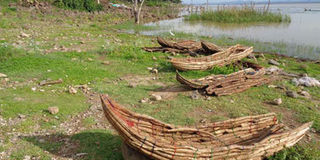Enchanted island life

Il Kadhish, the balsam rafts of the Il Chamus people, on Lake Baringo. PHOTO | RUPI MANGAT
What you need to know:
- The rivers into the lake are flowing again after the rains – Perkerra, Molo, Ndau and others. After the peak in 2013, thousands of birds have flocked to Baringo and sailing to the southern end, past the pair of the resident African fish eagles who have perched there for generations in stately demeanour. We’re watching flotillas of the Pink-backed pelicans that arrived in 2014.
- In the first light of the day, the sky over the lake is soft with splashes of soft pink in the horizon. Then the magic moment – the gold tip of the sun appears behind the Laikipia plateau and rises to a full orb sitting momentarily on the rim while I stretch and take deep breaths of the fresh morning air.
“It’s like you’re on a different planet, far removed from the stresses of the world,” says Dr Bonnie Dunbar, a woman of all seasons. We’re enjoying a glass of chilled white wine at the bar cum lounge of Island Camp on Ol Kokwe island, with Lake Baringo spread out all around us.
Dr Dunbar is a research scientist who is also into nutrition, wildlife and the art of fine living. When she stepped onto Ol Kokwe in 2003, she set up a basic camp for fossil finders Mary and Louis Leakey. It has evolved into a luxury camp now. “It’s a great place,” she says of the island. “It’s romantic, it’s peaceful and quiet and you have great views of the Great Rift Valley. It is so.
The rivers into the lake are flowing again after the rains – Perkerra, Molo, Ndau and others. After the peak in 2013, thousands of birds have flocked to Baringo and sailing to the southern end, past the pair of the resident African fish eagles who have perched there for generations in stately demeanour. We’re watching flotillas of the Pink-backed pelicans that arrived in 2014.
It’s a Garden of Eden by the estuary with thousands of Yellow-billed storks, White-backed pelicans, African spoonbills swishing their bills over the water’s surface, Crowned cranes and so many more including the African migrant, the Madagascar bee-eater. “I listed 80 species in 10 minutes just sitting here,” says Dunbar. It’s a fascinating jigsaw of colours against the green of the lakeshore swamp and the water.
STARK BLUE SKY
An Il Chamus fisherman in his il-kadish fishes. The raft is made from the buoyant wood, the balsam that’s so light you can pick the raft with one hand. It’s been used for centuries but at this point there is no balsam found around and so few of the rafts are seen.
Later on I am relaxing on the veranda of my art-deco suite – all open plan and spacious, with a curved wall that is a prop for a rain shower while the other side boasts a bedroom facing the bare cliff of Gibraltar Rock with the great stretch of the Laikipia plateau beyond it. There’s a private plunge pool to soak in when the sun gets a little too hot.
I take to the pool to work off the gourmet dinner from the night before – fish in champagne and saffron sauce. Every time I surface, my view of the world is a stark blue sky touching the waters of the lake and the blue of the pool. It’s invigorating, energising and I’m set for the evening on the island.
It’s full moon. The Goliath heron – i.e. the world’s largest heron flies across the lake to perch a few feet from me on the acacia and in complete contrast a pair of tiny colour-decked Pygmy kingfishers flit around. The sound of the islanders singing wafts through the air and constellations of the planetary bodies shine above the lake.
In the first light of the day, the sky over the lake is soft with splashes of soft pink in the horizon. Then the magic moment – the gold tip of the sun appears behind the Laikipia plateau and rises to a full orb sitting momentarily on the rim while I stretch and take deep breaths of the fresh morning air.
Enjoying a cup of morning coffee, there’s a splash below and then a crocodile floats past, unhurried and at total ease. Chatting with the local Il Chamus women in the village, a hippo surfaces, yawns with its enormous jaws wide and then goes under.
With the rains, the island is covered in a sea of tiny white flowers. There fish being dried and women doing their chores. Island life is enchanting.
****
Ol Kokwe
You can access Ol Kokwe by road via Nakuru – 270 kms from Nairobi. You can continue to Kabarnet, Eldoret on the western side or go north towards Samburu.
You can spa-stay or go water skiing, fishing or hiking to the hot springs on the island. Or visit the recently discovered footprints of a human ancestor on Keneth Kimosop Rutto’s land, high on the cliffs of mainland Baringo.




